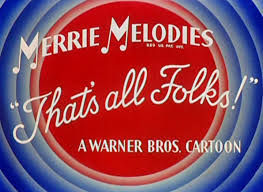Music and Cartoons (3): Other WB characters
- Cheng-I V. Chen Liu

- 5 sept 2020
- 4 Min. de lectura
Actualizado: 11 sept 2020
Warner Bros. Entertainment Inc. (also known as Warner Bros, or WB) is a American company founded in 1923. To get an idea of their amount of works, just in the forties (under the collections of "Looney Tunes" and "Merry Melodies"), more than 300 short films were released.

There are several other characters, besides Bugs Bunny, linked to Warner Bros. In this post, I would like to point out a few of those short films that belong to WB group, but where Bugs Bunny is not the main character.

- Boy will love "Rhapsody in Rivets" (1941). In this episode, we will hear, again, the most famous Hungarian Rhapsody ever written for the piano, the second one, composed by Franz Liszt (1811-1886). The music sounds in a construction site: the manager "conducts", the workers are the instruments in the orchestra, the architectural plans "acting" like the music score... Everything seems to be at the craziest, but somehow, it makes sense! You can check it out here.
- "Notes to you" (1941) uses "Largo al factotum", an Gioachino Rossini's (1792-1868) opera aria from "The Barber of Seville" and "Finale" from the second act of "Lucia di Lammermoor" opera, composed by Gaetano Donizetti (1797-1848), and some other more popular tunes. At the beginning, we will hear the famous lullaby "Wiegenlied" op. 49/4 of Johannes Brahms (1833-1897). Porky Pig wants to go to sleep, but a cat is willing to sing and disturbs Porky's night rest.
- "A Corny Concerto" (1943) is an episode with music composed by Johann Strauss II ("Tales from the Vienna Woods" y "The Blue Danube"). In the credit titles, we can also listen to a short part of Piotr Ilych Tchaikovsky's (1840-1893) first Piano Concerto (the most famous one, since the composer wrote another two but they didn't become as popular as his No. 1). The venue is an imaginary auditorium named "Corny-gie Hall" (instead of the real "Carnegie Hall").

It is a parody of Silly Symphonies and the film "Fantasia" (1940) of Walt Disney. If you watch this episode with kids, you can exploit it and talk about nature (the forest, the trees, the river, the lake, the swans...). Bugs Bunny is the main character in the first half, while the second half is based on "The Ugly Duckling" fairy tale, written by Hans Christian Andersen (1805-1875).
- Next, I am going to talk about "Pigs in a Polka" (1943), which features music of Brahms, specifically from the set "21 Hungarian Dances", number 5, 6, 7 and 17, in orchestral arrangement (the original was composed for the duet of piano four hands).

It is also a parody of two other previous works of Disney company: "The 3 little pigs" (a Silly Symphony of 1933) and (again) the film "Fantasia" (1940). Here, the actions and movements of the pigs are synchronized with the music and thanks to this we can feel the emotions that are shown in the images (happiness, joy, anxiety, fear...)
- A few years later, "Back Alley Oproar" (1948) was released. It is remake of "Notes to you" (1941). Instead of Porky Pig we will see Elmer Fudd and the cat will be played by Sylvester. The same music as in the original of 1941 is employed here.
- "A Ham in a Role" (1949) is starred by two Gopher Goofy and a dog that spouts fragments of William Shakespeare's books (belonging to Hamlet, Julio César, Romeo and Juliet, and Richard the III). The dog will quote while "classical" music sounds in the background:

the Oberture of "Poet and Peasant" by Franz von Suppé (together with Hamlet), "Liebestraum No. 3" by Franz Liszt (together with Romeo and Juliet), "Die Erlkönig" by Franz Schubert (together with Richard the III), "Consolation" by Felix Mendelssohn (when the dog reaches the house in the countryside), and the second movement of Ludwig van Beethoven's 7th Symphony and "Parsifal" of Richard Wagner in the last scenes.

- "Zoom and Bored" (1957) has Coyote and Road Runner as stars. The music belongs to Bedrich Smetana (1824-1884), it is part of an opera written in 1866 ("The Bartered Bride"): the dance of the comedians. Will Coyote succeed in his pursuit, trying to chase "bip-bip" down? Why don't you check it, yourself?

- One of the latests films is "High Note" (1960), directed by Chuck Jones, again using Johann Strauss' "The Blue Danube" . Thanks to this animation short film we can approach music notation in a funny way: a note changes its place and forces the rest of the notes to move, trying to chase it. It is so irrational and preposterous!
In addition to Strass' music, we can find brief tunes of Irving Berlin ("How Dry I Am"), Joseph Winner ("Little Brown Jug"), Brahms' Lullaby... You can watch it here, it is a live recording of the tour "Bugs Bunny on Broadway".
The last episode I am going to talk about is "Hare ribbin'"(1944) where "Träumerei" by Robert Schumann (1810-1856) is heard for 30 seconds. This short film has two possible endings, any of them "too violent" for children to watch it (in my opinion). That's why I am NOT going to provide a link to the cartoon but, instead of that, I will offer a link to the piano piece, in the performance of Evelyne Dubourg (this very recording was the one included in the 2017 disc "99-Must-Have Cartoon Classic")
That's all, folks!
See you around!

Comentarios